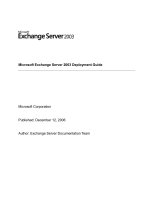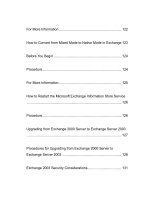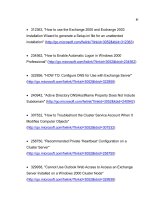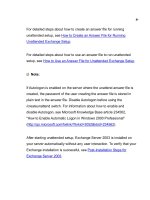Microsoft Exchange Server 2003 Deployment Guide- P35 doc
Bạn đang xem bản rút gọn của tài liệu. Xem và tải ngay bản đầy đủ của tài liệu tại đây (272.36 KB, 10 trang )
341
Table 3 Requirements for running Exchange Setup on a cluster
server
Area Requirements
342
Area Requirements
Permissions Account must be a member of a
group that has the Exchange Full
Administrator role applied at the
organization level.
Note:
An account that has the
Exchange Full Administrator role
applied at the administrative
group level can run Exchange
Setup on a cluster node if the
cluster node is a member of the
Exchange Domain Servers
group on the domain to which
the cluster node belongs.
When you install Exchange
Server 2003 into an existing
Exchange Server 5.5 organization,
additional permissions are required.
For information about the specific
permissions that are required to
install Exchange Server 2003 into
an existing Exchange Server 5.5
343
Area Requirements
File system
Installation drive cannot be the
cluster shared drive.
Installation drive must be the
same across all nodes.
Cluster resources
The MSDTC must be running on
one of the nodes in the cluster. The
clustered MSDTC resource should
exist in the default cluster group.
344
Area Requirements
Other
The fully qualified domain name
(FQDN) of the node cannot match
the Simple Mail Transfer Protocol
(SMTP) proxy domain of any
recipient policy.
Note:
A cluster with three or more
nodes is usually active/passive.
In active/passive mode, there
can be n – 1 or fewer Exchange
Virtual Servers, where n is the
number of nodes. For example,
if, by installing Exchange on a
node, the cluster becomes a
three-node cluster, and the
number of Exchange Virtual
Servers is three or more, then
Exchange Setup stops
installation until you remove one
of the Exchange Virtual Servers.
The Cluster service must be
initialized and running.
345
Area Requirements
If running Windows 2000 Windows 2000 Service Pack 4
(SP4) is required.
To obtain Windows 2000 SP4,
see the Windows 2000 Service
Packs Web site
( />Id=18353).
Ensuring That the Cluster Service is Running on Each Node
To successfully install Exchange Server 2003 on a server in a cluster, the
Cluster service must be installed and running on a cluster node. The
Cluster service is installed by default with Windows Server 2003,
Enterprise Edition and Windows Server 2003, Datacenter Edition.
However, the Cluster service is not installed by default with
Windows 2000 Server.
346
For detailed steps about how to confirm that the Cluster service is
running, see How to Verify that the Cluster Service is Running on Each
Node.
Installing and Enabling Required Windows Services
Exchange Server 2003 Setup requires that the following components and
services be installed and enabled on the server:
.NET Framework
ASP.NET
Internet Information Services (IIS)
World Wide Web Publishing Service
Simple Mail Transfer Protocol (SMTP) service
Network News Transfer Protocol (NNTP) service
If you are installing Exchange Server 2003 on a server running
Windows 2000, Exchange Setup installs the Microsoft .NET Framework
347
and ASP.NET automatically. You must manually install and start the World
Wide Web Publishing service, the SMTP service, and the NNTP service
before running Exchange Server 2003 Setup.
Important:
When you install Exchange on a new server, only the required services
are enabled. For example, the Post Office Protocol version3 (POP3)
and Internet Message Access Protocol version4 (IMAP4) services are
disabled by default on all of your Exchange Server 2003 servers. You
should only enable services that are essential for performing
Exchange Server 2003 tasks. The NNTP service should always remain
disabled. Although NNTP is required in order to install Exchange,
Exchange NNTP features are not supported and cannot be used on
clustered Exchange servers.
For detailed steps about how to install and enable the IIS prerequisites for
Exchange cluster running on Windows 2000, see How to Install IIS
Prerequisites for Exchange Server 2003 on Windows 2000.
For detailed steps about how to install and enable the IIS prerequisites for
an Exchange cluster running on Windows Server 2003, see How to Install
IIS Prerequisites for Exchange Server 2003 on Windows Server 2003.
348
Installing Microsoft Distributed Transaction Coordinator
Before you install Exchange Server 2003 on servers running Windows
Server 2003 or Windows 2000, you must first install the Microsoft
Distributed Transaction Coordinator (MSDTC) resource into the cluster.
It is an Exchange best practice to install the MSDTC resource into the
default cluster group. However, the MSDTC resource is the only resource
supported in the default cluster group. Exchange resources should not be
added to the default cluster group, as that configuration is not supported.
For detailed steps about how to install the MSDTC in a Windows 2000
server cluster, see How to Install the Microsoft Distributed Transaction
Coordinator in a Windows 2000 Server Cluster.
For detailed steps about how to install the MSDTC in a Windows Server
2003 server cluster, see How to Install the Microsoft Distributed
Transaction Coordinator in a Windows Server 2003 Server Cluster.
Note:
For more information, see Microsoft Knowledge Base article 312316,
"XADM: Setup Does Not Install Exchange 2000 Server on a Cluster if
349
the MSDTC Resource Is Not Running"
(
For more information about adding the MSDTC resource in Windows
Server 2003, see Microsoft Knowledge Base article 301600, "How to
Configure Microsoft Distributed Transaction Coordinator on a Windows
Server 2003 Cluster"
(
Note:
Knowledge Base article 301600 includes a reference to article 817064,
"How to enable network DTC access in Windows Server 2003"
( It is an
Exchange Server security best practice to not enable network DTC
access for an Exchange cluster. If you are configuring the Distributed
Transaction Coordinator resource for an Exchange cluster, do not
enable network DTC access.
Running Exchange Setup
Installing Exchange Server 2003 on a cluster is similar to installing
Exchange Server 2003 on non-clustered servers. For detailed steps
350
about how to run Exchange Setup in a Windows server cluster, see How
to Run Exchange Setup in a Windows Server Cluster.
Note:
Unattended Setup is not supported when installing Exchange
Server 2003 on a Windows cluster.
Before installing Exchange Server 2003 on a node, it is recommended
that you move all cluster resources owned by the node to another node.
Important:
Install Exchange Server 2003 completely on one node before you
install it on another node.
For important information about post-deployment steps, see Post-
Installation Steps for Exchange Server 2003. That topic includes
information about how to verify that your Exchange installation was
successful. It also includes information about how to upgrade your cluster
with the latest Exchange Server 2003 service packs and security patches.









